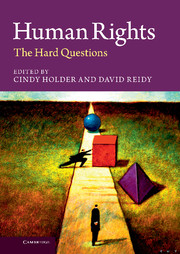Book contents
- Frontmatter
- Contents
- Figure
- List of table
- Notes on contributors
- Introduction
- Part I What are human rights?
- Part II How do human rights relate to group rights and culture?
- 4 The significance of cultural differences for human rights
- 5 Groups and human rights
- 6 Entangled
- 7 What does cultural difference require of human rights?
- Part III What do human rights require of the global economy?
- Part IV How do human rights relate to environmental policy?
- Part V Is there a human right to democracy?
- Part VI What are the limits of rights enforcement?
- Part VII Are human rights progressive?
- Index
- References
6 - Entangled
Family, religion and human rights
Published online by Cambridge University Press: 05 May 2013
- Frontmatter
- Contents
- Figure
- List of table
- Notes on contributors
- Introduction
- Part I What are human rights?
- Part II How do human rights relate to group rights and culture?
- 4 The significance of cultural differences for human rights
- 5 Groups and human rights
- 6 Entangled
- 7 What does cultural difference require of human rights?
- Part III What do human rights require of the global economy?
- Part IV How do human rights relate to environmental policy?
- Part V Is there a human right to democracy?
- Part VI What are the limits of rights enforcement?
- Part VII Are human rights progressive?
- Index
- References
Summary
Introduction
The family sits at the besieged juncture of the private and the public, intimate relations and communal affiliations, contract and status, state and faith-based jurisdictions, raising hard questions for human rights scholars and activists. This chapter focuses on contemporary dilemmas that place minority religious women at the center of charged debates about diversity and equality. It explains the critical role these debates play in broader citizenship and membership, human rights and private ordering challenges that have emerged recently in neoliberal states, before turning to explore possible ideas for overcoming, or at least mitigating, the current impasse.
Informed by jurisprudence from the world of comparative constitutionalism, the geopolitical focus of my discussion will be on secularized societies in Europe and North America that have adopted a relatively sharp distinction between secular, state-centered legal institutions and other types of institutions (religious, voluntary associations, communal dispute resolution processes, subnational or transnational institutions). Harold Berman famously argued that “it was out of the explosive separation of the ecclesiastical and the secular polities that there emerged the modern Western legal science” (Berman 1977, 898). This transformation has been accompanied by the creation of a “special class of legal professionals (lawyers), themselves trained in a body of legal doctrine which had been systematized into a particular legal science or jurisprudence” (Ahdar and Aroney 2010, 7). This professionalization and secularization of Western legal science both resulted from and enabled the rise of the familiar constitutional structure of “separation of church and state,” although there are significant variations even within this model, in terms of conceptual origins, comparative manifestations, institutional structures, and so on (Esposito and DeLong-Bas 2001; Hirschl 2010).
- Type
- Chapter
- Information
- Human RightsThe Hard Questions, pp. 115 - 135Publisher: Cambridge University PressPrint publication year: 2013



